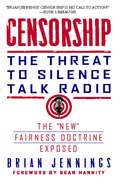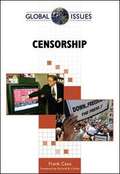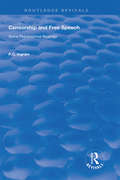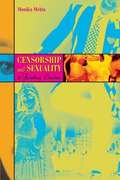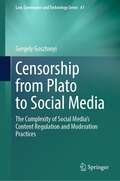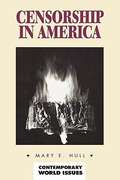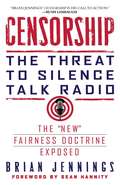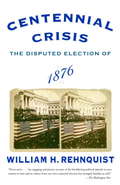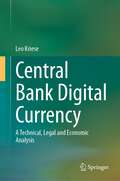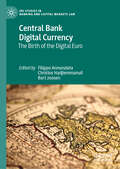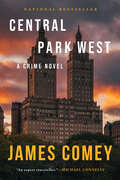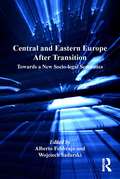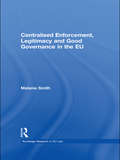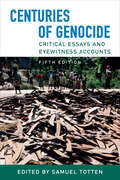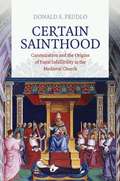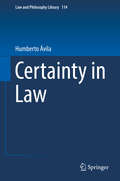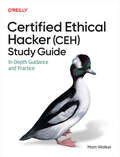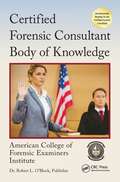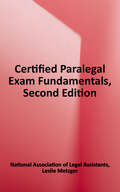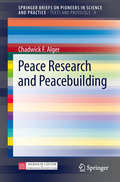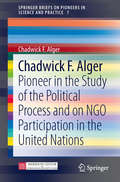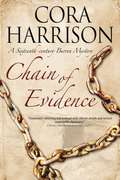- Table View
- List View
Censorship
by Sean Hannity Brian JenningsFreedom of speech. It is our most cherished privilege as Americans, guaranteed by the First Amendment to the U.S. Constitution since 1791. But our current presidential administration threatens to sharply curtail or silence altogether the freedom of expression that distinguishes America from the average dictatorship. What is under direct attack? Conservative talk radio. During the Reagan administration, conservative talk radio burgeoned when the FCC voted to stop enforcing the Fairness Doctrine, which required all licensed broadcasters to present "balanced" viewpoints on controversial issues. The format was a smash hit, attracting an estimated 50 million listeners weekly. Popular, profitable, outspoken, powerful, influential--it's what the American people wanted, and its success was the Democrats' worst nightmare. Now, the principles underlying the Fairness Doctrine threaten to be reinstated. Under cover of being "fair," they will be used as a means of censorship, allowing government to influence who owns our airwaves and thus controls the content, a mandate with far-reaching implications for all media--indeed, for freedom of speech for all Americans.
Censorship
by Frank CasoThe censorship practices of the United States, Russia, China, Zimbabwe and Egypt are summarized from a global perspective, and Caso (Wesleyan U.) notes that the electronic era has had little effect on these policies and practices. The reasons for censorship are explored and compared in each case, including suppression of public dissent, protecting religious dogma and even the rights of parents to protect their children from corrupting influences. Biographical information on key historical figures who are linked with censorship issues is also included in this volume, which is designed for students of law, global studies and history. Annotation ©2008 Book News, Inc., Portland, OR (booknews.com)
Censorship and Free Speech: Some Philosophical Bearings (Routledge Revivals)
by P.G. IngramThis title was first published in 2000: While there are many philosophical studies of free speech, treating censorship historically, politically, or by the medium restricted (films, press etc.), little has been written on censorship and free speech dealing with issues philosophically and approaching them from the perspective of restrictions. This book treats censorship and free speech as a problem of ideas, examining the issues as an aspect of our wider social and political lives and critically examining mainstream arguments against censorship. This unique approach takes issue with the concept of censorship as something aberrant, to examine where the limits of free speech lie in ensuring individual development and collective harmony. Examining the possibility of accepting censorship positively to serve legitimate purposes, it will be a thought-provoking challenge to prescriptive arguments for free speech.
Censorship and Sexuality in Bombay Cinema
by Monika MehtaIndia produces an impressive number of films each year in a variety of languages. Here, Monika Mehta breaks new ground by analyzing Hindi films and exploring the censorship of gender and heterosexuality in Bombay cinema. She studies how film censorship on various levels makes the female body and female sexuality pivotal in constructing national identity, not just through the films themselves but also through the heated debates that occur in newspapers and other periodicals. The standard claim is that the state dictates censorship and various prohibitions, but Mehta explores how relationships among the state, the film industry, and the public illuminate censorship's role in identity formation, while also examining how desire, profits, and corruption are generated through the act of censoring. Committed to extending a feminist critique of mass culture in the global south, Mehta situates the story of censorship in a broad social context and traces the intriguing ways in which the heated debates on sexuality in Bombay cinema actually produce the very forms of sexuality they claim to regulate. She imagines afresh the theoretical field of censorship by combining textual analysis, archival research, and qualitative fieldwork. Her analysis reveals how central concepts of film studies, such as stardom, spectacle, genre, and sound, are employed and (re)configured within the ambit of state censorship, thereby expanding the scope of their application and impact.
Censorship from Plato to Social Media: The Complexity of Social Media’s Content Regulation and Moderation Practices (Law, Governance and Technology Series #61)
by Gergely GosztonyiIn many countries, censorship, blocking of internet access and internet content for political purposes are still part of everyday life. Will filtering, blocking, and hacking replace scissors and black ink? This book argues that only a broader understanding of censorship can effectively protect freedom of expression.For centuries, church and state controlled the content available to the public through political, moral and religious censorship. As technology evolved, the legal and political tools were refined, but the classic censorship system continued until the end of the 20th century. However, the myth of total freedom of communication and a law-free space that had been expected with the advent of the internet was soon challenged. The new rulers of the digital world, tech companies, emerged and gained enormous power over free speech and content management. All this happened alongside cautious regulation attempts on the part of various states, either by granting platforms near-total immunity (US) or by setting up new rules that were not fully developed (EU). China has established the Great Firewall and the Golden Shield as a third way. In the book, particular attention is paid to developments since the 2010s, when Internet-related problems began to multiply. The state’s solutions have mostly pointed in one direction: towards greater control of platforms and the content they host. Similarities can be found in the US debates, the Chinese and Russian positions on internet sovereignty, and the new European digital regulations (DSA-DMA). The book addresses them all. This book will be of interest to anyone who wants to understand the complexities of social media’s content regulation and moderation practices. It makes a valuable contribution to the field of freedom of expression and the internet, showing that, with different kinds of censorship, this essentially free form of communication has come – almost by default – under legal regulation and the original freedom may have been lost in too many countries in recent years.
Censorship in America
by Mary E. HullThis book gives high school and undergraduate students a background of uncontested information and representative statements of the positions taken by opponents on current issues. Discusses why works of art and literature are considered controversial, profiles major figures who advocate or oppose censorship, reviews litigation and proposed legislation, lists and evaluates print and non-print information sources, and identifies organizations. Hull specializes in current events and books for young adults. Annotation c. Book News, Inc., Portland, OR (booknews.com)
Censorship of Literature in Post-War Poland: In Light of the Confidential Bulletins for Censors from 1945 to 1956
by Anna Wiśniewska-GrabarczykCensorship of Literature in Post-War Poland in the Light of Confidential Bulletins for Censors from 1945 to 1956, reconstructs and presents ways to censor literature (and, contextually, other fields of art) submitted for evaluation to the main censorship office in Poland during the first 11 years after WWII. The source material consists of confidential Bulletins – periodicals addressed to the officials of the censorship office.The book is divided into three main parts, each preceded by an introduction and concluded with an extensive bibliography.Part One: In Search of a Definition: What Were the Confidential Bulletins for Censors? Characteristics of the Source Material presents basic information about the Bulletins – their goals, structure, and material presented in them. The analysis concludes with the definition of confidential Bulletins of the censorship office.Part Two: Literature and Current Literary Phenomena Preconstructs the image of literary life presented in the Bulletins from 1945 to 1956. On numerous occasions, the Bulletins provided helpful guidelines in censorship practice. They discussed the job of dealing with literary texts and often gave examples of works published just a few months earlier or those that had not passed the scrutiny. The Bulletins published materials discussing literary phenomena and other issues. The ones previously unaccounted for (including film, radio and theatre), as well as the institutional background of control, I discuss briefly in the last part – Camera Censorica. What Else was Discussed in the Bulletins?.The materials presented in these confidential periodicals came from the Bulletins headquarters, field offices, and the work of censors. At the end of my study, Author let the censors speak. In the chapter Before the Proper Summary, or… the Censor as an Artist: The Literary Work of the Functionaries of Mysia Street and Its Environs, Author cite evidence of the literary ambitions of political functionaries – as censors had been called in the 1950s.
Censorship, Inc.: The Corporate Threat to Free Speech in the United States
by Lawrence SoleyThe First Amendment of the U.S. Constitution is a landmark in the defense of free speech against government interference and suppression. In this book we come to see how it also acts as a smokescreen behind which a more dangerous and insidious threat to free speech can operate. Soley shows how as corporate power has grown and come to influence the issues on which ordinary Americans should be able to speak out, so new strategies have developed to restrict free speech on issues in which corporations and property-owners have an interest. Censorship, Inc. is a comprehensive examination of the vast array of corporate practices which restrict free speech in the United States today in fields as diverse as advertsing and the media, the workplace, community life, and the environment. Soley also shows how these threats to free speech have been resisted by activism, legal argument, and through legislation. Grounded in extensive research into actual cases, this book is at the same time a challenge to conventional thinking about the nature of censorship and free speech.
Censorship: A Beginner's Guide (Beginner's Guides)
by Julian PetleyOffering a potted history of censorship from the execution of Socrates in 399BC to the latest in internet filtering, Petley also explains how today's media monopolies and moguls censor by limiting what news/entertainment they impart. Julian Petley is professor of Film and Television at Brunel University, UK. He is the author of several books on censorship.
Censorship: The Threat to Silence Talk Radio
by Sean Hannity Brian Jennings"Talk radio is the American voter." -- Rush Limbaugh Freedom of speech. It is our most cherished privilege as Americans, guaranteed by the First Amendment to the U. S. Constitution since 1791. But at the dawn of a new presidential administration, an epic battle is looming -- a battle for our airwaves that could sharply curtail or silence altogether the freedom of expression that distinguishes America from the average dictatorship. The target of this battle is conservative talk radio. If key Democrats have their way, the principles of the Federal Communications Commission's Fairness Doctrine will once again be enforced and allow government to control the content heard on free radio, a mandate that will have far-reaching implications for all media. During the Reagan administration the FCC voted to stop enforcing the Fairness Doctrine, which required all licensed broadcasters to present "balanced" viewpoints on controversial issues. Conservative talk radio burgeoned, giving rise to the father of conservative talk, Rush Limbaugh, and such hosts as Sean Hannity, Mark Levin, Michael Medved, Neal Boortz, Laura Ingraham, and others. The format was a smash hit -- resonating with listeners from coast to coast and giving a powerful voice to the conservative movement. Soon such programming, attracting an estimated 50 million listeners weekly, dominated the airwaves where liberal talk radio failed. Popular, profitable, outspoken, powerful, influential -- it's what the American people wanted, and its success was the Democrats' worst nightmare. Now, the principles of the Fairness Doctrine threaten to be reinstated -- if not directly, then through back-door tactics involving ownership of stations. Under cover of being "fair," they will prove to be anything but: They will be used as a means of censorship by those with contempt for conservative talk radio. With our current Congress firmly under Democratic control, the future of talk radio -- indeed, freedom of speech for all Americans -- is under direct attack.
Centennial Crisis
by William H. RehnquistNear midnight on Election Day in November 1876, the returns coming into Republican National headquarters signaled a victory for the Democratic presidential candidate, Samuel J. Tilden. But alert Republican leaders saw that if all the states still doubtful or disputed went for their candidate, Rutherford B. Hayes would be elected. Word was sent out to four southern states that their returns were crucial for a Hayes victory. Thus Chief Justice William Rehnquist begins this remarkable account of one of American's greatest political dramas, a crisis that was not resolved for nearly four months, on March 2, 1877, only two days before Inauguration Day. In his gripping story, Rehnquist tells how each party maneuvered to buy votes in the southern states, how the country slid into Congressional, judicial and public turmoil, and how the creation in January of an Electoral Commission (comprised of five Democrats, five Republicans and five Supreme Court justices) was opposed by both candidates. When that body's deciding vote was cast by Justice Joseph Bradley, public outcry reached such a fever pitch that the presidential swearing-in had to be held on a Sunday in near secrecry. Reaching beyond the history of a contentious election, the Chief Justice describes the political climate and economy of America in the 1870's, packing his narrative with biographical sketches of the central participants and opening a window on events in that decade that have long been overlooked. In a compelling epilogue we learn the occasions when Presidents, ranging from George Washington to Lyndon Johnson, have asked Supreme Court justices to arbitrate disputes, settle treaties or serve on investigating commissions. Almost always the justices were berated and attacked for their decisions. Would it be better for them to have refused the president’s request? The Chief Justice has some surprising answers.
Central Bank Digital Currency: A Technical, Legal and Economic Analysis
by Leo KrieseThis book offers a deeper understanding of digitisation and innovative technologies in the financial sector. It focuses on a digital version of sovereignly created money that is accessible to the broad public. This central bank digital currency (CBDC) raises several questions. Will CBDC lead to public surveillance of the citizens? What is digital money in the legal sense? And what is the difference to already existing forms of digital money? This book addresses main questions associated with central bank digital currency by providing background information as well as in-depth analyses. The book introduces a basic understanding of innovative technologies such as the distributed ledger technology. It shows how a system of money can be created and what roles each participant has. Taking an economic point of view, the book demonstrates the monetary policy in the euro area and examines how a digital version of public money could affect the transmission mechanism as well as the financial stability. Could CBDC lead to a "digital bank run"? Could it replace the established financial intermediaries such as banks? What would that mean to the economy?Mainly, the book focuses on the legal issues of CBDC. Which is the competent institution for establishing digital public money? Will digital money change the way of how we handle financial data? Also, the book examines the legal usability of CBDC in the economy. How can digital money based on innovative technologies be transferred in accordance with the law? Can a debtor of a monetary claim flee into the digital currency? This book addresses the public and private sector participants as well as the legislators on how to handle CBDC. Most important, the book addresses everyone interested in digitisation and innovative financial technology who wants to gain a deeper understanding of the next big evolvement of money.
Central Bank Digital Currency: The Birth of the Digital Euro (EBI Studies in Banking and Capital Markets Law)
by Filippo Annunziata Christos Hadjiemmanuil Bart JoosenThis book looks at the new phenomenon of Central Bank Digital Currency (CBDC) with a focus on the launch of the Digital Euro in the European Union. It contains treatment of the subject of CBDC from various perspectives, with each of the authors formulating viewpoints regarding this new phenomenon. It also offers an insightful assessment of the legal status of a central bank digital currency, engaging in the theoretical effort of testing the legal implications of the birth of a digital complement to cash. The chapters focus on the rationale for a digital Euro, its ability to aid financial inclusion, the constitutional foundations of the CBDC, demands of a digital euro on the side of the beneficiaries of the retail payment system, and the “mechanics” of the CBDC in relation to its issuance and governance. It will be of interest to financial services, banking, financial regulation, and monetary policy researchers and scholars alongside lawyers and policymakers.
Central Park West: A Crime Novel
by James ComeyA Newsweek and Reader's Digest most-anticipated read of 2023. In the thrilling first crime novel from the former director of the FBI, a murder investigation reveals deadly connections between high-ranking politicians and the mafia. The gripping crime fiction debut from former FBI director James Comey takes readers deep inside the world of lawyers and investigators working to solve a murder while navigating the treacherous currents of modern politics and the mob. When a years-long case against a powerful mobster finally cracks and an unimpeachable witness takes the stand, federal prosecutor Nora Carleton is looking forward to putting the defendant away for good. The mobster, though, has other plans. As the witness’s testimony concludes, a note is passed to the prosecution offering up information into the assassination of a disgraced former New York governor, murdered in his penthouse apartment just days before. It’s enough to blow the case wide open, and to send Nora into a high-stakes investigation of conspiracy, corruption, and danger. Drawing from the author’s decades in federal law enforcement, including his years in Manhattan as a mob prosecutor and later the chief federal prosecutor, Central Park West is a fast-paced legal thriller with an intriguing plot enriched by real-life details and experiences. That unique perspective gives the novel much of its allure, but it’s the unforgettable characters, shocking twists, and courtroom scenes as authentic as they are dramatic that will leave readers looking forward to more from this bold new talent in the genre.
Central and Eastern Europe After Transition: Towards a New Socio-legal Semantics (Studies In Modern Law And Policy Ser.)
by Wojciech SadurskiHow have national identities changed, developed and reacted in the wake of transition from communism to democracy in Central and Eastern Europe? Central and Eastern Europe After Transition defines and examines new autonomous differences adopted at the state and the supranational level in the post-transitional phase of the post-Communist area, and considers their impact on constitutions, democracy and legal culture. With representative contributions from older and newer EU members, the book provides a broad set of cultural points for reference. Its comparative and interdisciplinary approach includes a useful selection of bibliographical resources specifically devoted to the Central Eastern European countries' transitions.
Centralised Enforcement, Legitimacy and Good Governance in the EU (Routledge Research in EU Law)
by Melanie SmithArticle 226 EC is the central mechanism of enforcement in the EC Treaty, and has remained unchanged since the original Treaty of Rome. It provides the European Commission, as guardian of the Treaty, with a broad power of policing Member States’ conduct. Article 226 has been traditionally characterised as an arena of secretive negotiation focused on the sole function of effective enforcement. This study seeks to move beyond this approach by characterising Article 226 as a multi-functional mechanism within the Treaty. It does this by examining the central mechanism of enforcement through the normative lenses of legitimacy, good administration and good governance. Centralised Enforcement, Legitimacy and Good Governance in the EU is interdisciplinary in nature, examining law in its political context. It focuses on how the institutions interact and react to competing policy pressures, and explores the tensions that lie at the heart of legitimacy in the actions of public actors by engaging with concepts such as democracy, legitimacy and good administration. Scholars and policy-makers whose work explores Article 226 will find this work especially relevant. It will also appeal to those who are interested in enforcement and regulation in the international/EU arena, as well as those whose work considers concepts such as good governance, legitimacy, and accountability in the EU. It is also relevant to scholars engaged in the study of institutions and processes of interaction and change.
Centuries of Genocide: Critical Essays and Eyewitness Accounts, Fifth Edition
by Samuel TottenThe new edition of this market-leading textbook includes a revised introduction and updated chapters with new research and insights. Four new case studies of twenty-first-century genocides bring this horrific history up to the present moment: the genocide perpetrated by the government during Argentina’s "Dirty War," the genocide of the Yazidis by the Islamic State of Iraq and Syria (ISIS), genocidal violence against the Rohingya in Myanmar, and China’s genocide of the Uyghurs. Powerful survivor testimonies bring the essays to life and help readers grapple with the difficult lessons presented throughout the book.
Certain Sainthood: Canonization and the Origins of Papal Infallibility in the Medieval Church
by Donald S. PrudloThe doctrine of papal infallibility is a central tenet of Roman Catholicism, and yet it is frequently misunderstood by Catholics and non-Catholics alike. Much of the present-day theological discussion points to the definition of papal infallibility made at Vatican I in 1870, but the origins of the debate are much older than that. In Certain Sainthood, Donald S. Prudlo traces this history back to the Middle Ages, to a time when Rome was struggling to extend the limits of papal authority over Western Christendom. Indeed, as he shows, the very notion of papal infallibility grew out of debates over the pope's authority to canonize saints.Prudlo's story begins in the twelfth and thirteenth centuries when Rome was increasingly focused on the fight against heresy. Toward this end the papacy enlisted the support of the young mendicant orders, specifically the Dominicans and Franciscans. As Prudlo shows, a key theme in the papacy's battle with heresy was control of canonization: heretical groups not only objected to the canonizing of specific saints, they challenged the concept of sainthood in general. In so doing they attacked the roots of papal authority. Eventually, with mendicant support, the very act of challenging a papally created saint was deemed heresy.Certain Sainthood draws on the insights of a new generation of scholarship that integrates both lived religion and intellectual history into the study of theology and canon law. The result is a work that will fascinate scholars and students of church history as well as a wider public interested in the evolution of one of the world’s most important religious institutions.
Certainty in Law (Law and Philosophy Library #114)
by Humberto ÁvilaInstead of the usualapologetic treatment found in legal doctrine, linked to the determinacy,immutability or predictability of norms, this book treats legal certaintyinnovatively, holistically and in depth. Using a method at once analytical andfunctional, Professor Ávila examines the structural elements of legalcertainty, from its definition and foundations to its various dimensions,normative forces and efficacies, citing a wealth of examples from case law tosupport each of the theses defended. Nosubject is more important and topical than legal certainty. Problems relatingto lack of understanding, instability and unpredictability of law intensify dayby day everywhere, in civil law and common law countries alike. Normativesources are increasingly diverse in origin (national, international, community)and multiple in nature (legal, contractual, jurisprudential). They changeconstantly, and present increasingly frequent problems of ambiguity andvagueness that significantly hinder their comprehension. This state of affairs,which to a greater or lesser extent is true of any legal order, justifies areturn to the subject of legal certainty. In this book, essential questions areanswered such as: Legal certainty in what sense? Certainty of what, for whom,in whose vision and by whom? When, to what extent, and to what end? "(. . . ) it is probably themost comprehensive and systematic study ever produced on this subject using theanalytical method. " (Riccardo Guastini, Professor of Jurisprudence, Universityof Genoa, Italy)
Certified Ethical Hacker (CEH) Study Guide: In-Depth Guidance and Practice
by Matt WalkerThe CEH exam is not an enjoyable undertaking. This grueling, exhaustive, challenging, and taxing exam will either leave you better prepared to be the best cyber security professional you can be. But preparing for the exam itself needn't be that way. In this book, IT security and education professional Matt Walker will not only guide you through everything you need to pass the exam, but do so in a way that is actually enjoyable. The subject matter need not be dry and exhausting, and we won't make it that way. You should finish this book looking forward to your exam and your future. To help you successfully complete the CEH certification, this book will bring penetration testers, cybersecurity engineers, and cybersecurity analysts up to speed on: Information security and ethical hacking fundamentals Reconnaissance techniques System hacking phases and attack techniques Network and perimeter hacking Web application hacking Wireless network hacking Mobile, platform, IoT, and OT hacking Cloud computing Cryptography Penetration testing techniques Matt Walker is an IT security and education professional with more than 20 years of experience. He's served in a variety of cyber security, education, and leadership roles throughout his career.
Certified Forensic Consultant Body of Knowledge (Center For National Threat Assessment Ser. #1)
by 0 American College of Forensic Examiners InstituteIn a proper court setting, experts in various fields are often asked to provide testimony and evidence on numerous professional topics. To be able to effectively testify in a courtroom requires knowledge, training, experience, and expertise. The materials presented in Certified Forensic Consultant Body of Knowledge provide the necessary information
Certified Paralegal Exam Fundamentals
by National Association of Legal Assistants (Editor Various Roles"The book addresses general legal principles and broad areas of concern and is not intended to be a source of specific legal advice or solutions to particular problems. Rather, its goal is to provide the reader with an overall understanding of legal concepts associated with the CP Exam. <p><p>The purpose of the book is to assist examinees of NALA’s Certified Paralegal (CP) Exam in their preparation to successfully complete the exam and earn the credential. "
Chadwick F. Alger: Peace Research and Peacebuilding (SpringerBriefs on Pioneers in Science and Practice #9)
by Chadwick F AlgerThis is the third volume to commemorate the 90th birthday of the distinguished scholar Chadwick F. Alger to honor his lifetime achievement in international relations, as President of the International Studies Association (1978-1979) and as Secretary General of the International Peace Research Association (1984-1987). After a brief introduction by Chad F. Alger this volume presents six of his key texts on Peace Research and Peacebuilding, covering "The quest for peace: What are we learning?"; "The Emerging Toolchest for Peacebuilders"; "Peace Studies as a Transdisciplinary Project"; "Challenges for Peace Researchers and Peace Builders in the Twenty-First Century: Education and Coordination of a Diversity of Actors in Applying What We Are Learning"; "The escalating peace potential of global governance", "There Are Peacebuilding Tasks for Everybody", and "What Should Be the Foundations of Peace Education?"
Chadwick F. Alger: Pioneer in the Study of the Political Process and on NGO Participation in the United Nations (SpringerBriefs on Pioneers in Science and Practice #7)
by Chadwick F AlgerThis volume honors the lifetime achievements of distinguished scholar Chadwick F. Alger on the occasion of his 90th birthday. Carolyn Stephenson presents Prof. Alger as a Pioneer in the Study of the Political Process and on NGO Participation in the United Nations. Part 1 offers an autobiographical note and a comprehensive bibliography of his academic publications. Part II includes three texts on "The Political Process in the UN," namely "The Researcher in the United Nations: Evolution of a Research Strategy," "Interaction in a Committee of the United Nations General Assembly" and "Interaction and Negotiation in a Committee of the UN GA." In Part III, which focuses on "Civil Society Organizations in the UN System (NGOs)," three chapters deal with "Evolving Roles of NGOs in Member State Decision-making in the UN System," "The Roles of NGOs in the UN System: From Article 71 to a People's Millennium Assembly" and "Strengthening relations between NGOs and the UN system: Towards a research agenda."
Chain of Evidence: A Mystery of Medieval Ireland (Burren Mysteries #9)
by Cora Harrison"Harrison, like Peter Tremayne in his Sister Fidelma series, provides a superior brand of historical mystery" -Booklist. When clan leader Garrett MacNamara's dead body is found on the road after a herd of cows has escaped, what was initially assumed to be a tragic case of him being squashed to a pulp by livestock becomes more sinister when a local claims they saw a chain attached to the mutilated body--which has now disappeared. Mara and her scholars must now investigate: was Slaney, Garrett's wife, threatened by two new arrivals, or is she being blamed for his murder to clear the way for a new leader . . .
